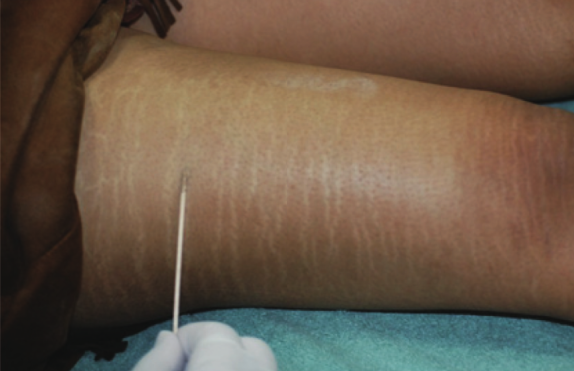
In scar tissues, the skin’s natural elasticity is weakened or entirely lacking. This is because haphazard formation of scar tissues replaces the original elastic fibers, which also cause an aesthetic problem. This is part of the natural wound healing process, however, if the site of the wound still show abnormal color and texture 6 months after, and is too rigid and inelastic, one can say it will stay that way for good. Tattooing can be used to make aesthetic improvements. Tattoo procedures can be carried out as soon as the skin’s natural healing process is complete. It is better to leave the skin to heal itself before putting it through the stress of treatment. Make sure to begin tattoo treatment after the wound has sufficiently matured.
As for the previous question on whether tattooing can be done on a wound or not, I would like to answer that it depends on the maturity of the scars and the current skin condition. Before face to face consultation, I first check the patient’s skin condition through photographs. To increase the convenience of our patients, I have them email or text me photos of their stretch marks to advise them of the right timing of the tattoo procedure. I ask the patient about when the scars started appearing and why.
About 70% of all patients get information on when to do the treatment and the cost through remote consultation. Other important information is given during face to face consultation. When the patient comes in for a visit, I then check the characteristics of the wound with palpation. In this tiered consultation process, patients obtain a lot of important information about their own lesions.

Figure2. Matching the color to the normal skin.
Hypertrophic Scars and Keloids
Many patients think the wound on their skin is a keloid.However, most of these cases are hypertrophic scars and not keloids. It is important to explain the difference between keloids and hypertrophic scars. Keloids are a contraindication to tattoo procedures as keloids are likely to have unexpected responses including uneven ink distribution, pigment loss, and exacerbation of the keloid. However, a hypertrophic scar is not problematic, as long as the protruded skin is addressed correctly. For example, if the protrusion is too pronounced and will affect the outcome, a steroid injection such as triamcinolone to smooth the protrusion before the tattoo procedure.
Fortunately, stretch marks tend to be without protrusion. However, they do present indented surfaces and a cautious approach is needed. When the scar surface is even, you can focus only on recovering the normal skin color. However, stretch marks have indented surfaces which can create shadows over the lower surface and make it appear darker. Therefore, I advise carrying out the treatment in 2-3 phases to allow gradual adjustments, rather than try to achieve the desired result in one treatment.
HELIOSⅡ/LOTUSⅡ/HYPERION – Manufacturer: LASEROPTEK(www.laseroptek.com)
The Color of the Stretch Marks
Patients are very often too eager to achieve quick results. They also often forget my advice during the first consultation. It is important to clearly communicate that a single procedure will not bring the desired effect. Especially, when you are dealing with aesthetic outcomes, subjective perspectives play a role. What patients feel about the color change can differ from the doctor’s assessment of it. We take photographs before and after treatment but there are always a few patients that are not satisfied. Again, phasing the treatment into 2-3 procedures can help reduce patient complaint. The interval between procedures should be at least a month. Personally, I would prefer to wait six months for the skin to heal completely but no patient would tolerate such a long gap. It is best to check the outcome 1-2 months after the previous procedure. If the patient is particularly eager to see quick improvements, carry out part of the second procedure after a month’s interval.
As I have already explained, the focus is to match the color of the stretch marks to the surrounding normal skin. Figure 2 shows this process and Figure 3 shows the skin taking on a slightly darker tone after treatment. This darker tone can persist as in Figure 4. In vitiligo, the initial color may be darker than the surrounding skin but in time the color fades slightly creating a more natural appearance. However, as stretch marks are scars, one should not aim toward a tone darker than the surrounding skin. As shown in Figure 4, dark tattoo lines are not aesthetically desirable.
-To be continued




















